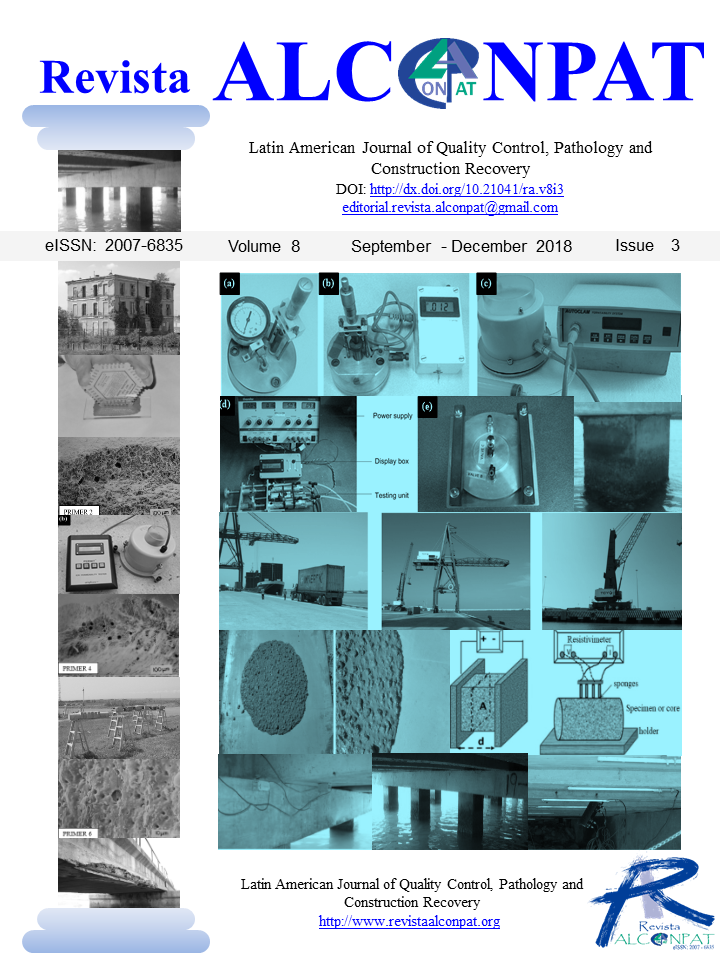Service life design and modelling of concrete structures – background, developments, and implementation
Abstract
The paper presents an international overview of current knowledge and progress in service life design and modelling of concrete structures. It explores why service life modelling is needed, and indicates that modern demands for longevity, durability, and sustainability of concrete structures cannot be fulfilled without service life modelling. It addresses the current approaches to durability design and specification and concludes that a move to performance-based approaches is imperative for progress to be made. Examples from international experience are cited to illustrate progress that has been made. Lastly, the paper discusses ways of moving forward, recognizing that the philosophical bases are already in place in the form of general code formulations, but which need to be converted into useful approaches.
Downloads
References
Alexander, M. G. & Ballim, Y. (1993), “Experiences with durability testing of concrete: a suggested framework incorporating index parameters and results from accelerated durability tests”. Proc. 3rd Canadian Symp. on Cement and Concrete, Ottawa, August 1993, Nat. Res. Council, Ottawa, Canada, 1993: 248-263.
Alexander, M. G., Mackechnie, J. R., Ballim, Y. (2001), "Use of durability indexes to achieve durable cover concrete in reinforced concrete structures, Chapter, Materials Science of Concrete, V. VI, Ed. J. P. Skalny and S. Mindess, American Ceramic Society, pp 483 – 511.
Alexander, M. G., Ballim, Y., Stanish, K. (2008), “A framework for use of durability indexes in performance-based design and specifications for reinforced concrete structures”, Materials & Structures, V. 41, No. 5, pp. 921-936.
Alexander, M. G., Santhanam, M. (2013), “Achieving durability in reinforced concrete structures: durability indices, durability design and performance-based specifications”. Keynote paper at International Conferences on Advances in Building Sciences & Rehabilitation and Restoration of Structures, IIT Madras, Chennai, India, 21pp.
Alexander, M. G. & Thomas, M. (2015), “Service Life Prediction and Performance Testing – Current Developments and Practical Applications”. Cement & Concrete Research, Vol 78, pp. 155-164.
Alexander, M. G. Ed. (2016a), “Marine concrete structures. Design, durability and performance”. Ed. M.G. Alexander, Cambridge: Woodhead Publishers (Imprint of Elsevier). 400 pp.
Alexander, M. G. (2016b), “Performance-based concrete durability design and specification in South Africa – background, implementation, and quo nunc?” Proceedings fib Symposium, Cape Town, Lausanne, fib, pp. 52-62.
Alexander, M. G., Bentur, A., Mindess, S. (2017), “Durability of Concrete: Design and Construction”. CRC Press, Taylor & Francis Group, U.K.
Andrade, C., Alonso, C., Goni, S. (1993), “Possibilities for electrical resistivity to universally characterize mass transport processes in concrete”. In Concrete 2000 Economic and durable construction through excellence Volume Two: Infrastructure, research, new applications. Dhir, R. K. and Jones, M. R. ed. Scotland, UK: E & FN SPON, pp. 1639–1652.
Andrade, C. (2004), “Calculation of initiation and propagation periods of service life of reinforcements by using the electrical resistivity”. In International Symposium: Advances in Concrete through Science and Engineering. Evanston, Northwestern University, USA, (2004) p. 8.
Andrade C, Alonso C, Gulikers J, Polder R, Cigna R, Vennesland Ø, Salta M, Raharinaivo A, Elsener B. (2004), "RILEM TC 154-EMC: Electrochemical Techniques for Measuring Metallic Corrosion. Recommendations Test methods for on-site corrosion rate measurement of steel reinforcement in concrete by means of the polarization resistance method", Materials & Structures V. 37, No. 273, pp. 623-643.
Andrade, C., Izquierdo, D. (2005), “Benchmarking through an algorithm of repair methods of reinforcement corrosion: the Repair Index Method”, Cement & Concrete Composites, V. 27, No. 6, pp.727-733.
Andrade, C., d’ Andrea, R. (2010), “Electrical resistivity as microstructural parameter for modelling of service life of reinforced concrete structures”, In 2nd International symposium on service life design for infrastructure. pp. 379–388.
Australian Standard (AS) (2007), AS 1379: “Specification and Supply of Concrete”. Sydney:
Standards Australia.
ASTM International. (2010). ASTM C457/C457M-10a Standard Test Method for Microscopical Determination of Parameters of the Air-Void System in Hardened Concrete. Retrieved from https://doi.org/10.1520/C0457_C0457M-10A
ASTM International. (2010). ASTM C1202-10 Standard Test Method for Electrical Indication of Concrete's Ability to Resist Chloride Ion Penetration. Retrieved from https://doi.org/10.1520/C1202-10
ASTM International. (2004). ASTM C1556-04 Standard Test Method for Determining the Apparent Chloride Diffusion Coefficient of Cementitious Mixtures by Bulk Diffusion. Retrieved from https://doi.org/10.1520/C1556-04
ASTM International. (2004). ASTM C1585-04e1 Standard Test Method for Measurement of Rate of Absorption of Water by Hydraulic-Cement Concretes. Retrieved from https://doi.org/10.1520/C1585-04E01
Bickley, J. A., Hooton, D. and Hover, K. C. (2006), “Performance specifications for durable concrete”. Concrete International, 28(9): 51-57.
Canadian Standards Association (2004), CAN/CSA-A23.1-04/A23.2-04: Concrete Materials and Methods of Concrete Construction/Methods of Test and Standard Practices for Concrete, Toronto, 516 pp.
Day, K. W. (2005), “Prescriptive on prescriptions”, Concrete International, V. 7, pp.27–30.
DuraCrete (1998), “Probabilistic performance-based durability design: modelling of degradation”, Document, D. P. No. BE95-1347/R4-5, The Netherlands.
EN 1990-1 (2002), Eurocode: “Basis of structural design”, CEN, Brussels, 2002.
EN 206-1 (2013), “Concrete - Part 1: Specification, performance, production and conformity, CEN, Brussels, 2013.
fib Model Code for Service Life Design (2006) fib Bulletin 34, fib, EPFL Lausanne, 116 pp.
fib Model Code (2010, 2013), International Federation for Structural Concrete (fib), Lausanne, Switzerland.
Gjørv, O. E. (2014), “Durability Design of Concrete Structures in Severe Environments”, 2nd edition, Taylor & Francis, CRC Press, London.
Gouws, S. M., Alexander, M. G., Maritz, G. (2001), “Use of durability index tests for the assessment and control of concrete quality on site”, Concrete Beton, 98 pp. 5-16.
Guillon, E., Le Bescop, P., Lothenbach, B., Samson, E. and Snyder, K. (2013), “Modelling degradation of cementitious materials in aggressive aqueous environments”, Part II in Star 211-PAE, Performance of cement-based materials in aggressive aqueous environments, pp. 1- 39. Springer.
ISO 13823-1 (2008), “General Principles on the design of structures for durability”, International Organization for Standardization, Geneva.
ISO 2394 (2015), “General Principles on Reliability for Structures”, International Organization for Standardization, Geneva, 111pp.
Jacobs, F., Leemann, A., Denarié, E., Teruzzi, T. (2009), SIA 262/1. “Recommendation for the quality control of concrete with air permeability measurements”, VSS report, Zurich. 22 pp.
LIFE-365 (2005). ACI-Committee-365, “Service life prediction model, Computer program for predicting the service life and life-cycle costs of reinforced concrete exposed to chlorides”. American Concrete Institute.
Linger, L., Cussigh, F. (2018), “PERFDUB: A New French Research Project on Performance-Based Approach for Justifying Concrete Structures Durability”. In High Tech Concrete: Where Technology and Engineering Meet.1. https://doi.org/10.1007/978-3-319-59471-2
Lobo, C., Lemay, L. and Obla. K. (2005), “Performance-based specifications for concrete”. The Indian Concrete Journal, 79(12): 13-17.
Mackechnie, J. R, Alexander, M. (2002), “Durability predictions using early-age durability index testing”. Proceedings, 9th Durability and Building Materials Conference, Australian Corrosion Association, Brisbane, (2002) 11pp.
Muigai, R. N., Alexander, M. G., Moyo, P. (2009), “Use of chloride conductivity index in probabilistic modelling for durability design of RC members”. Restoration of Building Monuments Journal, V. 15, No. 4, pp. 267-276.
National Ready-mix Concrete Association, (NRMCA), n.d. www.nrmca.org/P2P
Neville, A. M. (1987), “Why we have concrete durability problems”, ACI SP-100, Katherine and Bryant Mather International Conference on Concrete Durability, American Concrete Institute, Detroit, USA, pp. 21-48.
Nganga, G., Alexander, M. G., Beushausen, H. (2013), “Practical implementation of the durability index performance-based design approach”. Construction & Building Materials, Published online: 6-MAY-2013. Construction and Building Materials. V. 45, pp. 251-261.
Nilsson, L. O., Poulsen, E., Sandberg, P., Sørensen, H.E., Klinghoffer, O. (1996), “Chloride penetration into concrete”, State of the Art, Transport processes, corrosion initiation, test methods and prediction models, Copenhagen: Danish Road Directorate, pp.23-25.
NTBUILD 492, (1999), “Concrete, mortar and cement based repair materials: chloride migration coefficient from non-steady state migration experiments”. Esbo, Finland: Nordtest.
Raath, B. (2004), “Practical Issues of Concrete Specification”. Concrete Society of Southern Africa, National Seminar: Specifying Concrete for Durability - State of the Art of South African Practice, Presented at Johannesburg Durban, Port Elizabeth and Cape Town, South Africa.
RILEM TC 189-NEC (2005), “Non-destructive evaluation of the concrete cover: Comparative test - Part I: Comparative test of ‘penetrability’ methods”. Materials and Structures (284), 2005.
Ronny, R., Everitt, P. (2010), “Durability specification and testing results from four bridge structures in Kwa Zulu-Natal”, In Concrete for a sustainable environment, Emperor's Palace, Kempton Park, Gauteng, South Africa.
The South African National Roads Agency Limited (SANRAL) (2010), “Project document: Project specifications”.
Simons, B. (2004), “Concrete performance specifications: New Mexico Experience”. Concrete International, 26(4): 68-71.
Streicher, P., Alexander, M. G. (1995), "A chloride conduction test for concrete." Cement and Concrete Research, V. 25, No. 6, pp 1284-1294.
Swiss Standard SN 505 262/1 (2013), "Concrete Construction – Complementary Specifications", Schweizer Norm, 52 p. (in German and French)
Tang, L. (2008), “Engineering expression of the ClinConc model for prediction of free and total chloride ingress in submerged marine concrete”, Cement and Concrete Research, 38(8–9), 1092–1097.
Taylor, P. (2004), “Performance-Based Specifications for Concrete”, Concrete International, 8: 91 – 93.
Thomas, M. D. A., Green, B., O’Neal, E., Perry, V., Hayman, S. Hossack, A. (2012), “Marine Performance of UHPC at Treat Island”, Proceedings of Hipermat, 3rd International Symposium on UHPC and Nanotechnology for High Performance Construction Materials (Editors Michael Schmidt et al), Kassel, pp. 365-370.
Torrent, R. J. (1992), “A two-chamber vacuum cell for measuring the coefficient of permeability to air of the concrete cover on site, Materials & Structures, V. 25, No. 6, pp.358-365.
Torrent, R., Denarié, E., Jacobs, F., Leemann, A., Teruzzi, T. (2012), “Specification and site control of the permeability of the concrete cover: The Swiss approach”, Materials and Corrosion, V. 63, No. 12, pp.1127-1133.
Torrent, R., Jacobs, F. (2014), "Swiss Standards 2013: World's most Advanced Durability Performance Specifications", 3rd Russian Intern. Confer. on Concrete and Ferrocement, Moscow.
Tuutti, K. (1992), “Corrosion of steel in concrete”. Swedish Cement and Concrete Research Institute, CBI Research Report, No. 4 p 82.
Van der Lee, J., De Windt, L., Lagneau, V. (2008), “Application of reactive transport models in cement-based porous media”. Proceedings in the International RILEM Symposium on Concrete Modelling – CONMOD’08, Delft, The Netherlands.
Walraven, J. (2008), “Design for service life: how should it be implemented in future codes”, International Conference on Concrete Repair, Rehabilitation and Retrofitting, Proceedings ICCRRR Cape Town, (2008) pp. 3-10.
_______________________________
License in effect from September 2020
You are free to:
- Share — copy and redistribute the material in any medium or format for any purpose, even commercially.
- Adapt — remix, transform, and build upon the material for any purpose, even commercially.
- The licensor cannot revoke these freedoms as long as you follow the license terms.
Under the following terms:
- Attribution — You must give appropriate credit , provide a link to the license, and indicate if changes were made . You may do so in any reasonable manner, but not in any way that suggests the licensor endorses you or your use.
- No additional restrictions — You may not apply legal terms or technological measures that legally restrict others from doing anything the license permits.
Notices:
You do not have to comply with the license for elements of the material in the public domain or where your use is permitted by an applicable exception or limitation .
No warranties are given. The license may not give you all of the permissions necessary for your intended use. For example, other rights such as publicity, privacy, or moral rights may limit how you use the material.





















.png)














